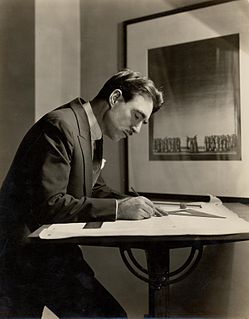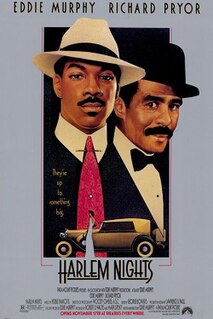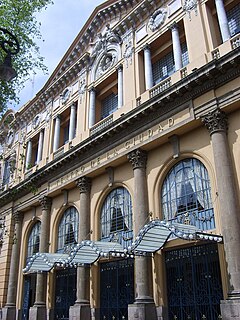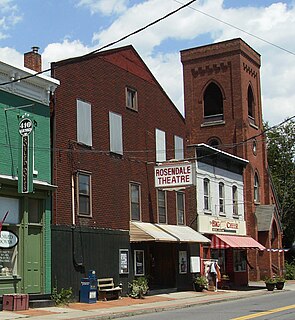
Wilmington is a city in and the county seat of Clinton County, Ohio, United States. The population was 12,660 at the 2020 census. At city entrances from state routes, county roads, and U.S. highways, the city slogan of "We Honor Our Champions" is seen, accompanied by signs that highlight various athletic accomplishments from Wilmington individuals and teams. The city features a weather forecast office of the National Weather Service, which serves all of Southwestern Ohio and portions of Kentucky and Indiana.

Johnathan Southworth Ritter was an American actor. Ritter was a son of the singing cowboy star Tex Ritter and the father of actors Jason and Tyler Ritter. He is known for playing Jack Tripper on the ABC sitcom Three's Company (1977–1984), and received a Primetime Emmy Award and a Golden Globe Award for the role in 1984. Ritter briefly reprised the role on the spin-off Three's a Crowd, which aired for one season, producing 22 episodes before its cancellation in 1985.

Stagecraft is a technical aspect of theatrical, film, and video production. It includes constructing and rigging scenery; hanging and focusing of lighting; design and procurement of costumes; make-up; stage management; audio engineering; and procurement of props. Stagecraft is distinct from the wider umbrella term of scenography. Considered a technical rather than an artistic field, it is primarily the practical implementation of a scenic designer's artistic vision.

A safety curtain is a fire safety precaution used in large proscenium theatres. It is usually a heavy fibreglass or iron curtain located immediately behind the proscenium arch. Asbestos-based materials were originally used to manufacture the curtain, before the dangers of asbestos were widely known. The safety curtain is sometimes referred to as an iron in British theatres, regardless of the actual construction material.

The Iroquois Theatre fire occurred on December 30, 1903, at the Iroquois Theatre in Chicago, Illinois, United States. It was the deadliest theater fire and the deadliest single-building fire in U.S. history, resulting in at least 602 deaths.

Harlem Nights is a 1989 American crime comedy-drama film starring and directed by Eddie Murphy, who also wrote. The film co-stars Richard Pryor, Michael Lerner, Danny Aiello, Redd Foxx, Della Reese, and Murphy's older brother Charlie. The film was released theatrically on November 17, 1989, by Paramount Pictures. The film tells the story of "Sugar" Ray and Vernest "Quick" Brown as a team running a nightclub in the late 1930s in Harlem while contending with gangsters and corrupt police officials.

Amy Marie Yasbeck is an American actress. She is best known for her role as Casey Chappel Davenport on the sitcom Wings from 1994 to 1997, and for having played the mermaid Madison in the television film Splash, Too in 1988. She has guest starred in several television shows and appeared in the films House II: The Second Story, Pretty Woman, Problem Child, Problem Child 2, The Mask, Robin Hood: Men in Tights, and Dracula: Dead and Loving It.

The Rowland Theater, located at 127 North Front Street, Philipsburg, Centre County, Pennsylvania, United States, is an historic single screen movie theater, built in 1917 by Charles Hedding Rowland. The theater is owned by the borough of Phillipsburg.

The Fox Theater in Spokane, Washington is a 1931 Art Deco movie theater that now serves as a performing arts venue and home of the Spokane Symphony. It was designed by architect Robert C. Reamer, notable for his design of the Old Faithful Inn in Yellowstone National Park. It was part of the Fox Film Corporation Empire founded by studio mogul William Fox. The theater opened September 3, 1931 and showed films continuously until it closed September 21, 2000 after an engagement of the movie Gladiator starring Russell Crowe.

The Betsy is a 1978 American romantic drama film directed by Daniel Petrie, from a screenplay by William Bast and Walter Bernstein, based on the 1971 novel of the same name by Harold Robbins. It stars Laurence Olivier as a retired auto tycoon, with Robert Duvall, Katharine Ross, Tommy Lee Jones, and Jane Alexander in supporting roles.

Theater drapes and stage curtains are large pieces of cloth that are designed to mask backstage areas of a theater from spectators. They are designed for a variety of specific purposes, moving in different ways and constructed from various fabrics. Many are made from black or other darkly colored, light-absorbing material. Theater drapes represent a portion of any production's soft goods, a category comprising any non-wardrobe, cloth-based element of the stage or scenery. Theater curtains are often pocketed at the bottom to hold weighty chain or to accept pipes to remove their fullness and stretch them tight.

The Croswell Opera House is a historic theater located at 129 East Maumee Street in Adrian, Michigan. It is recognized as the oldest theater in the state and among the oldest continuously operating theaters in the United States. The theater was designated as a Michigan Historic Site on March 2, 1976 and later added to the National Register of Historic Places as the Adrian Union Hall-Croswell Opera House on April 18, 1985.

The Grand Opera House in Seattle, Washington, US, designed by Seattle architect Edwin W. Houghton, a leading designer of Pacific Northwest theaters, was once the city's leading theater. Today, only its exterior survives as the shell of a parking garage. Considered by the city's Department of Neighborhoods to be an example of Richardsonian Romanesque, the building stands just outside the northern boundary of the Pioneer Square neighborhood.

A front curtain, also known as a (front-of-)house curtain, act curtain, grand drape, main curtain or drape, proscenium curtain, or main rag is the stage curtain or curtains at the very front of a theatrical stage, separating it from the house.

The Sottile Theatre is a theater in downtown Charleston, South Carolina. It is owned by the College of Charleston and is a rental venue used by many local, regional and national performing arts groups including Spoleto Festival USA. It has 785 seats and was built in the 1920s by Albert Sottile.

The Teatro de la Ciudad was built as the Teatro Esperanza Iris in 1918 and is now one of Mexico City’s public venues for cultural events. The theater is located in the historic center of Mexico City on Donceles Street 36.
Duvetyne, or duvetyn, is a twill fabric with a velvet-like nap on one side. It may be woven from cotton, wool, or—in rare cases, mainly in the early 20th century—silk. Duvetyne has a matte finish and its high opacity makes it ideal for blocking light.

The Rosendale Theatre is a three-story, 260-seat movie theater and performance venue in Rosendale Village, a hamlet and former village in the town of Rosendale in Ulster County, New York. The building was opened as a casino in 1905, and began showing films in the 1920s. By the 1930s, a stage had been installed for live vaudeville and burlesque acts. The casino was eventually taken over by the local government, and used to house the town's fire department.

The Holyoke Opera House was a theatre operating in Holyoke, Massachusetts during the 19th and early 20th centuries. Built in 1877, and christened on March 25, 1878, the theater was built by then-mayor William Whiting who privately-funded its construction along with the adjoining "Windsor House" hotel. Designed by architect Clarence Sumner Luce, its interior was decorated by painter and designer Frank Hill Smith, who is best known today for the frescoes in the House of Representatives' chamber in the Massachusetts State House, and whose commission for the venue's main hall paintings has been described by the American Art Directory and historian John Tauranac as one of his definitive works.

The Embassy Theatre, also known as the Embassy 1 Theatre, is a former movie theater at 1560 Broadway, along Times Square in the Midtown Manhattan neighborhood of New York City. Designed by Thomas W. Lamb, the theater opened in 1925 at the ground floor of 1560 Broadway, the headquarters of the Actors' Equity Association. While no longer in use as a theater, the space is preserved as a New York City designated landmark, and it continues to operate as a store.



























